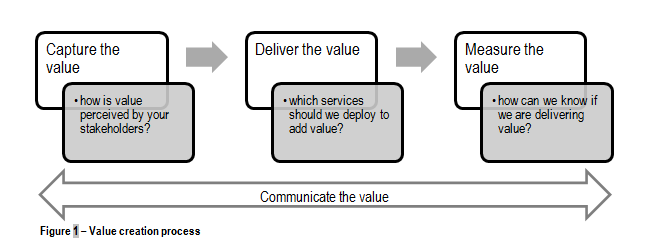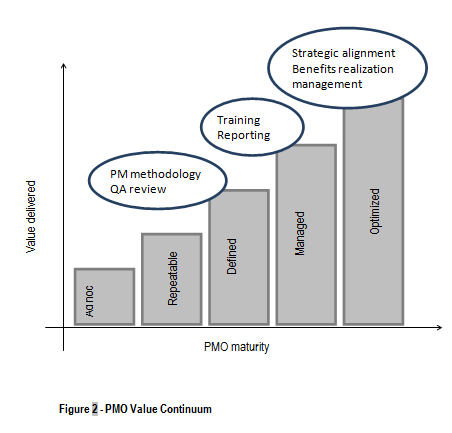THE VALUE OF A PMO – (PART 1/2)
July 27, 2015
In this article, we will discuss the definition of value, the value creation process and ways to deliver these values as a PMO.
From buzzword to valuable word: What is value after all?
‘Value,’ add ‘value,’ added ‘value‘ solution – You have certainly heard this word in different contexts, read in various articles and presentations and also discussed about it. It’s everywhere and in the project management world the situation is no different. Everything is about value nowadays, but what does this mean to your organization and to your PMO?
Is it value for money? Is it achieving your strategic objectives? Is it the benefits delivered? Is it about better performance and happy stakeholders? Or, is it all of these combined?
It may seem like a trivial matter of semantics, but semantics do matter if you want to have a common shared understanding of the world you live in. Then, let’s start there. What is value after all?more–>
Value is an individual interpretation defined by those who use and/or pay for it and can be described as a relationship between quality and cost, or a trade-off between investment and costs. Value is what you expect to get- that is the positive impact to be achieved. It is your “bang for the buck”.
It is also very important to map your PMO goals to your company goals. In the end, it boils down to the question: How are the projects, programs and the portfolio, I am working on, facilitating the achievement of my company goals? And, maybe more importantly, how do you communicate this to the people within your team? Bottom line – the value of a PMO lies in the fact that it proactively facilitates in the achieving of company goals.
Where lies the value of a PMO?
The challenges of our times point to just one direction: In a highly unpredictable and complex environment, organizations cry more and more for predictability, setting the scene for the discipline of Project Management to flourish.
Coincident with the growing awareness to the importance of Project Management worldwide, the implementation of Project Management Offices, aka PMOs, has faced an exponential growth in the last decade, and a large number of organizations now have, or are planning to have a PMO in place.
While the implementation of PMOs was sort of a fad, the focus is now on measuring the actual value added by these structures in organizations, as a considerable number of PMOs still keep failing (looking back to 2010, 50% closed within 4 years, according to ESI’s The State of the PMO 2010 Survey) .
In fact, there is no point in stating that PMOs add value, if value is just a buzzword, without a clear and meaningful significance. PMOs can bring value to an organization in several ways, and this is dependent on a number of factors such as the type of PMO (e.g. centre of excellence, project support office, portfolio management office), its maturity level, its remit, or the range of services provided. However, in general terms, we can say that there are ten areas where their contribution can be quite noteworthy:
- Consistency of best-fit-practices, terminology, and processes, leading to discipline and alignment of expectations and behaviours
- Visibility over the status and progress of projects that enables Senior Management to gain a general overview of the portfolio and actually decide with ‘lights on’
- Transparency through independent, objective and unbiased audits and recommendations, able to act as a source of truth, based on facts
- Quality through quality reviews of project deliverables and management products, that ensures that products are complete, delivered according to acceptance criteria and fit for purpose
- Assurance allow confidence, management by exception, and informed decision-making, by performing rigorous reviews, providing recommendations, and challenging assumptions, estimates, and approach
- Predictability of delivery timescales and costs, and of resource requirements, enabling agility, foresight for long-term, and capacity planning
- Accountability through a clear definition of roles and responsibilities, allowing people to be held accountable of delivery and benefits realization
- Alignment and focus, so that effort and resources are put in the right, priority initiatives; and only projects that contribute to the organization’s strategic objectives are carried out and not those that are not aligned
- Organizational learning of what is to be replicated and what is to be avoided in the future, through the establishment of risk and knowledge databases that enable knowledge transfer across projects
- Resilience by running ‘what-if’ scenarios, exploring project dependencies, and ensuring that mitigation/exploitation strategies are covered for organizations to leverage their risks and opportunities and be resilient
Due to its positioning in the organizational structure, PMOs can act as a communicating bridge between strategy planning and strategy execution, and perhaps this is where their main value lies – they are business-driven strategic partners and integrators, in addition to being enablers of organizational change and drivers for business success. In fact, high-performant PMOs don’t just support the execution of strategy through delivery of projects and programs, but they actually shape the strategy by playing an active role in strategic planning. There is a lot to be gained from PMOs in such cases, but it is important to remark that the simple existence of a PMO in the organization is not enough to ensure value creation. PMOs are not silver bullets and, since there is not a single type of PMO, the value of each PMO is unique to its characteristics and organizational environment.
There are as many types of PMOs as there are companies in the world. Each PMO is unique and the potential value they provide will be in accordance to that. A classical configuration of PMOs is that of a Project Support, where the PMO is mostly the project manager’s assistant, whose functions and services consist mainly of administrative support such as arranging meetings and producing meeting minutes, updating the project logs, and taking care of the project plan and general project paperwork. While this type of PMO can prove of use in the day-to-day work of a Project Manager (I’m sure he will appreciate the help!), there is little value to be gained at the organizational level just by having a PMO performing an administrative role. If you are relying just on a Project Support Office, you are not unlocking the full potential of value that a PMO can provide.
Value needs to be captured, delivered, measured and communicated if a PMO wants to be successful in its mission of value creation. Let’s explore this cycle now.
The Value Creation Process
Capturing value
Value lies in the eyes of the beholder. What ‘value’ means for Senior Management can be very different from what it means for Project Managers or for the PMO team. If the PMO is focused on defining a methodology for risk management, but the main concern of the organization is on reducing cost overruns, then value is ‘being delvered but is not being perceived. On the other hand, if project managers are struggling in dealing with unexpected events in their projects, they would thank the support that a risk management methodology brings and would perceive it as valuable. For that reason, it’s crucial that the PMO actually asks and understands from its key stakeholders what their expectations are, what keeps them awake at night, what do they expect from a PMO, i.e., what their view of value is. The PMO needs to actively engage with its customers, establish the case for its existence, and create a sense of shared ownership, bearing in mind that no one destroys what one helps to build.
Delivering Value
Magic happens when the expectations of the business are met or exceeded; and this is where PMOs walk the talk and people perceive that value is being delivered. Of course, it should be noted that if you are setting up a PMO just now, you won’t be able to deliver all sizes and shapes of value at once. In fact, this would be dependent on your PMO type and your PMO maturity level; where value is added as the PMO matures, improving its services and introducing new ones. The broader the scope, the higher the visibility and impact of the PMO. If you are just starting, however, you would probably start by doing the basics well first, investing in standardization and consistency, before attempting to build portfolio reporting, for instance. Value is circumstantial and unique to the particular organization and context. All PMOs have limitations and very few are delivering all the value they would like to, but you will need to start somewhere. Thus, a phased and incremental approach, aligned with the PMO and project management maturity in the organization, is important. Even if you believe your PMO is now on a desired maturity level, it’s important to note that the most effective PMOs are the ones, which continue to add value, specifically, by changing and reinventing themselves.
Pressure of the time-to-market, merciless competition and time filled with ‘firefighting’ and business as usual activities may sometimes restrict the time you get to work on creating value throughout projects. Always pose yourself the question: Am I adding value today? Sometimes, companies are not aware of how much time they spent on business as usual vs on added-value projects. In other cases, this is a matter of a poor understanding of what is urgent vs what is important. In other cases also, it all goes back to a lack of prioritization of projects/resources, where companies lacking this oversight waste resources (people, money, time) on initiatives that don’t add that much value, that is, they are doing the wrong projects. PMOs can play a pivotal role to ensure that the company is making the best use of their resources and, actually, working on the projects that add value. By providing visibility over the workload in the portfolio and assisting in project prioritization, they ensure that your time is spent on the valuable stuff. They are definitely right when they say that ‘time is money,’ but make no mistake – time is value.
In the next article – THE VALUE OF A PMO – (Part 2/2) – we will discuss the ways, in which you can measure the value of a PMO and communicate this. In the mean time, we are curious about your thoughts on:
“What is the value of having a PMO in your (corporate) organization?”
This article is a joint effort of Marisa Silva, PMO Analyst at Oxford University Press and Rick Bouter, PMO at the Capgemini University & Sogeti Labs and Capgemini Expert Connect member.
Related posts

 English | EN
English | EN 

